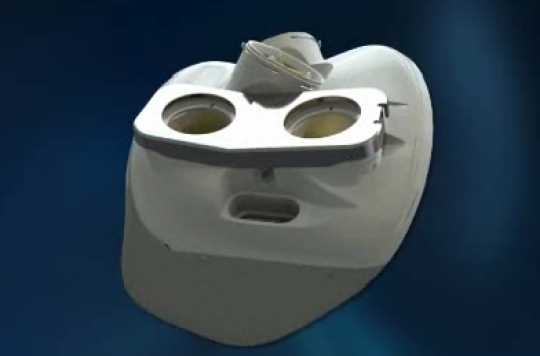For the first time in the world, an artificial heart has been implanted in humans. The intervention took place at the Georges-Pompidou hospital in Paris, on a patient suffering from end-stage heart failure.

It was a world first and moreover a French one! A total artificial heart was implanted in a 75-year-old man on December 18 at the Georges Pompidou European Hospital (HEGP), in Paris. Developed by Prof. Alain Carpentier, the total artificial heart was designed by the Italian company Carmat. The culmination of 25 years of research. This prosthesis could constitute an alternative to heart transplants. “This first implantation took place satisfactorily, the prosthesis automatically ensuring normal circulation at a physiological rate”, the Carmat company indicated yesterday in a press release. Three other patients should soon be operated. On this occasion, why actor managed to interview the Prof. Christian Latrémouille, cardiac surgeon at HEGP, the one who implanted the 1er artificial heart to the world on a man. At our microphone, the latter did not hide his great pride and confided the emotion present in the operating room during the operation. But then, how does this artificial heart work, and who are the patients who will be able to benefit from this extraordinary invention.
The best answer to end-stage heart failure
As explained by the CARMAT company in a press release posted online yesterday, this artificial heart project, “the most efficient in the world”, today constitutes the only credible answer to all cases of advanced heart failure in the phase. terminal.
We speak of heart failure when the heart can no longer perform its essential function of pumping blood and irrigating all the other organs. The main causes are coronary heart disease and high blood pressure. The most frequent complications are arrhythmias, thromboembolic events (formation of clots) and renal failure. It is a severe, progressive and often fatal disease. Almost half of patients die within a year of first hospitalization.
To date, more than 20 million patients are affected by this disease in Europe and the United States. So, thanks to the continued development of its total artificial heart, CARMAT aims to compensate for the notorious lack of transplants to which tens of thousands of people suffering from advanced heart failure are victims today.
How does this artificial heart work
The prosthesis created by CARMAT engineers includes 2 right and left ventricular cavities, each separated by a flexible biomembrane in 2 volumes, one for the blood, one for the actuation fluid. A soft outer bag holds the actuation fluid and beats at the heart rate.
By hydraulic actuation via two miniature motor-pump units, the actuating liquid moves this biomembrane by reproducing the movement of the ventricular wall of the human heart during contraction. This movement causes the admission and ejection of blood under optimal conditions: usual movement, contact only with biologically compatible materials.
Finally, an integrated electronic device regulates the operation of the prosthesis according to the needs of the patients from information given by sensors and processed by a microprocessor. (see the video below)
The requirements of this innovation
All implants and devices for assisting or replacing organs in contact with the blood pose the essential problem of their hemocompatibility, which can generate the destruction of red blood cells (hemolysis) or activate the coagulation chain (thrombosis) which leads to the formation of a clot blocking a blood vessel and causing pulmonary embolism or stroke. But with this 1st total artificial heart, CARMAT succeeded in reproducing the physiological movement of ejection through the membrane, mimicking the ventricular contraction and ensuring the emptying of the ventricles at each cycle. And to perfect this hemocompatibility, these engineers used synthetic and biological microporous biomaterials allowing a continuous protein coating adhering to all surfaces in direct contact with the blood. This artificial heart is also the only device using biological valves which has demonstrated their low long-term thrombogenicity.
In addition, the designers have won the bet of anatomical compatibility. CARMAT has thus optimized the shape of its biomimetic heart and miniaturized all the sub-assemblies of medical regulation to integrate them into the prosthesis, while maintaining a physiological ejection volume, even under sustained effort.
In addition, the challenge of autonomy has also been taken up. CARMAT is now able to offer the patient comfort, quality of life and a normal rhythm of life thanks to a very large autonomy in a light and carried system, i.e. at least 12 hours in a maximum of 3 kg thanks to compact and renewable energy.
Finally, the latest feat achieved by Prof. Carpentier, and the engineers at CARMAT, is that of physiological adaptation. It is not the least. Thus, this artificial heart reacts to these physiological needs by reproducing, using proprietary algorithms, the response of the natural heart, in particular by maintaining the aortic pressure to permanently ensure satisfactory perfusion of the organs. This innovation also manages to adjust the flow and frequency to the activity to eliminate the discomfort associated with fixed parameters.
In the end, the day after the intervention, the main protagonists of this feat, however, remain cautious. “We are delighted with this first implantation, but it would of course be premature to draw any conclusions because it is a single implantation and a post-surgical timeframe still very short,” concludes Marcello Conviti, the Director. General of CARMAT.
.

















